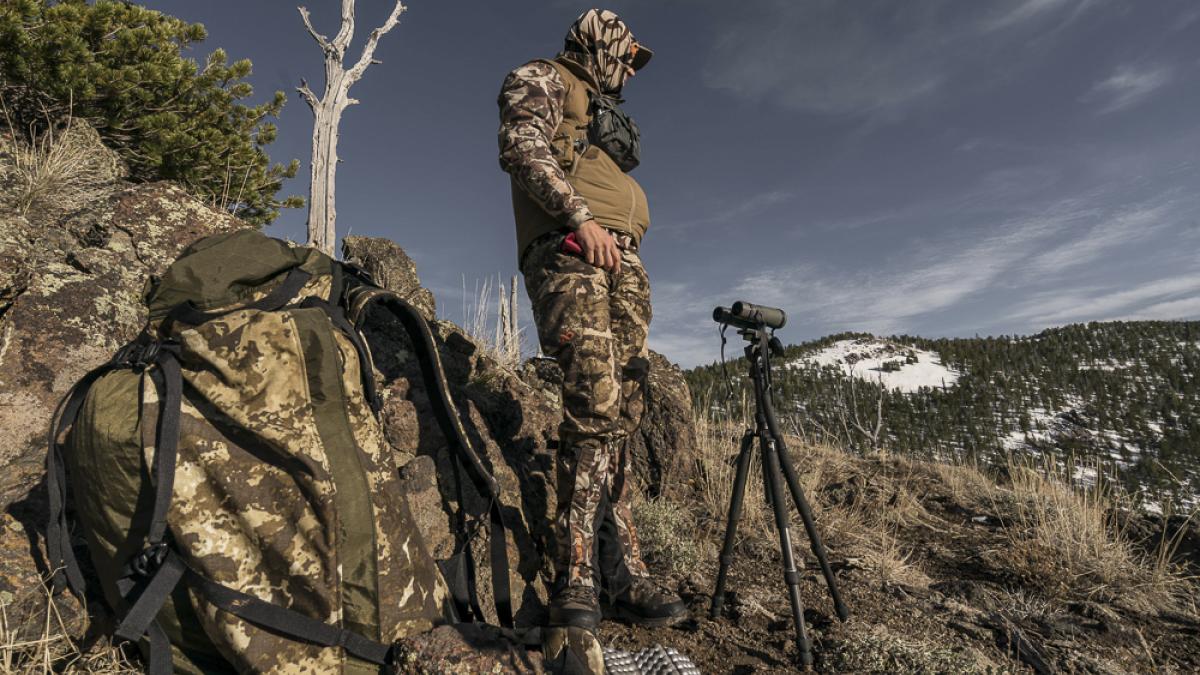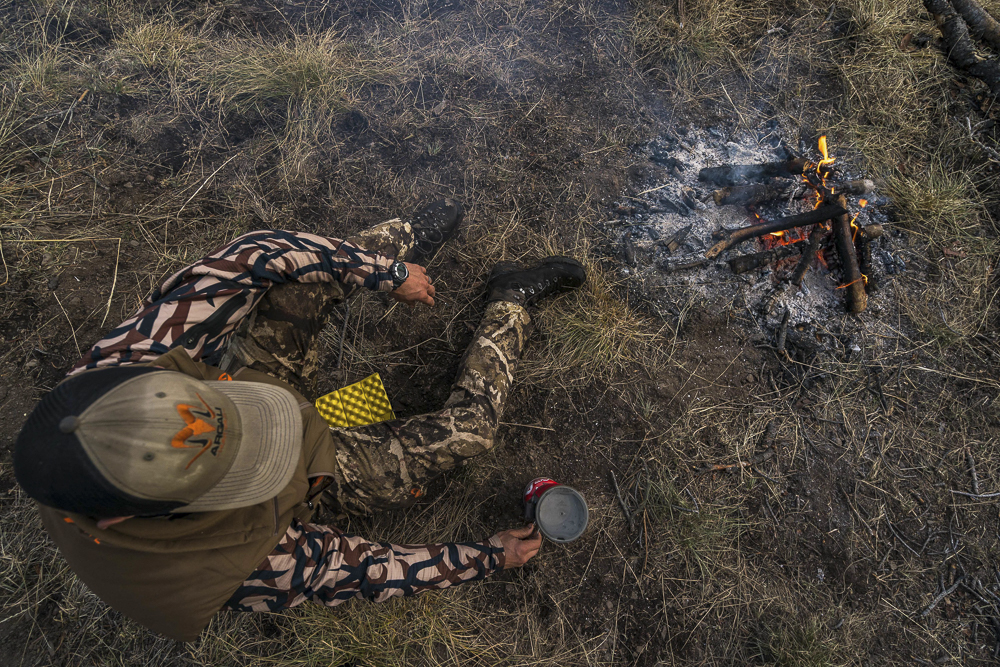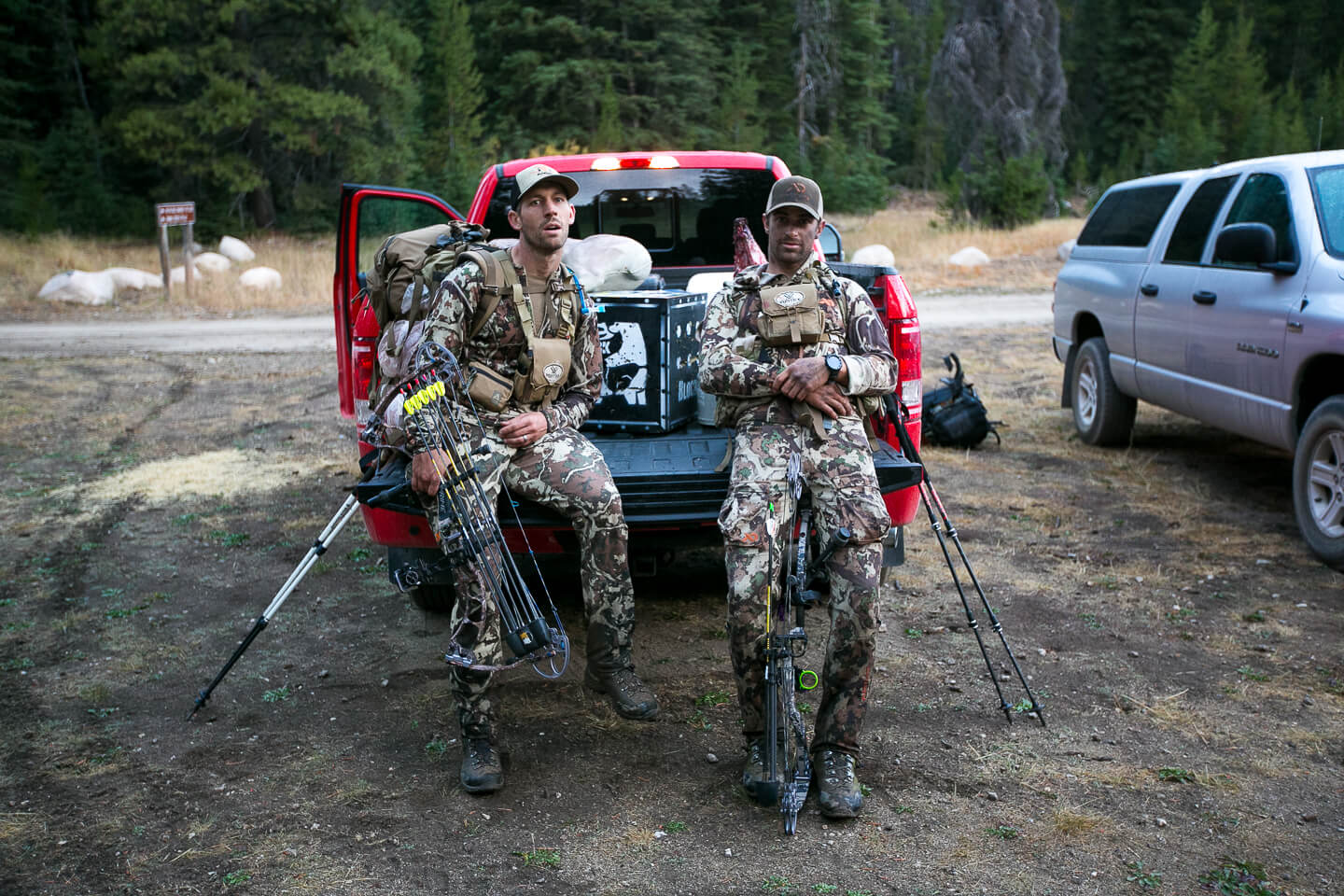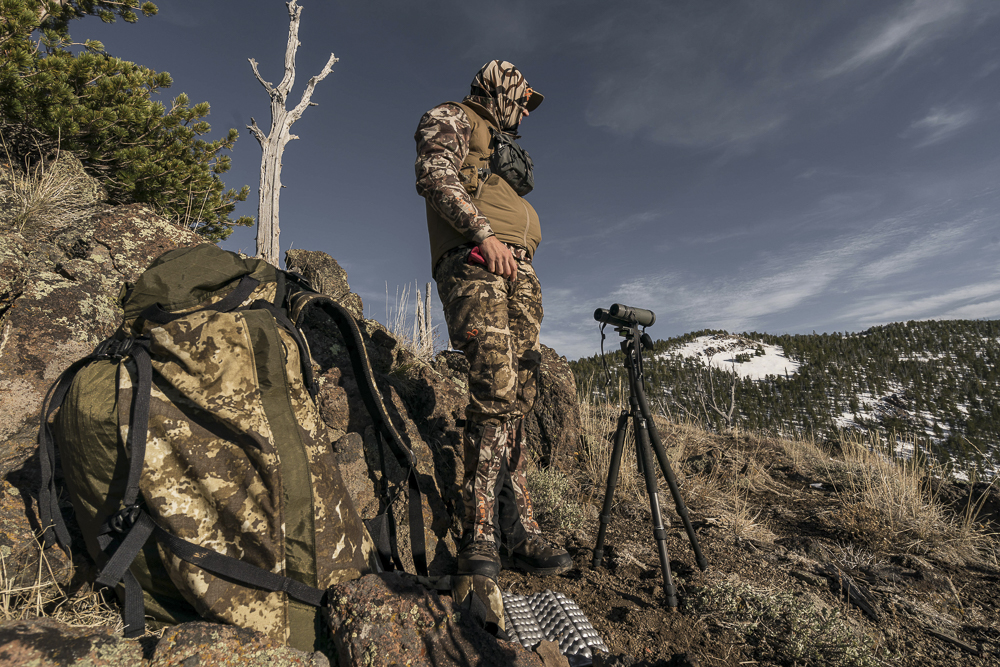
Hiking Boots Vs. Running Shoes for Hunting
As an ounce-counting hunter, I tend to lean hard towards a philosophical belief that lighter is better when it comes to hunting gear. At one point in my hunting life, I went off the proverbial minimalist deep-end and would only carry around a self-made wool backpack that was big enough to carry a 3 liter water bladder, some food and a knife. The pack had sewn nylon shoulder straps and two-buckle straps on the outside to carry a jacket. It was amazingly light, but that setup had serious drawbacks.
Hunting boots are one piece of gear though, where I have become a skeptic of my own philosophy, particularly after hearing some complaints about foot problems from some mountain hunters. Using a lightweight shoe or boot has always seemed so intuitive to me that it didn't require much explanation or thought.
But the move towards using running shoes in the mountains by a number of backcountry hunters, and the foot problems I have anecdotally heard from a handful of hunters that have done it made me want to look into whether the weight benefits of using a running or minimalist shoe is a wise choice for most hunters.
Not to get too far ahead of ourselves, but there may be some important lessons to learn from the tens (hundreds?) of millions of dollars the medical industry made after the book Born to Run was released. That book, which is a good read, essentially made the pitch that humans were made physiologically to run barefoot, or with very little on our feet.
After reading it, millions of runners started using minimalist shoes, sometimes using only leather sandals for long runs including marathons and ultra marathons. That cultural movement ended—rather quickly—after resulting in an untold number of serious and long-term injuries. I think there are some parallels between the minimalist shoe movement, and some important lessons for hunters to pay attention to, which we will discuss later.

Lighter is Better, Right?
There is a common refrain among ultra-light backpackers and hikers that has been loosely floating around the internet that goes like this: “a pound of weight savings on your feet equals 5 pounds of weight savings on your back”. This phrase floats around so loosely you would assume it is a well known fact that doesn't need any explanation. The general assumption is that the lighter your shoe the easier it is to walk, and as the miles add up on a hike the less energy you will expend lifting your legs.
Intuitively this is a sexy and logical argument. If you have 10 pound weights on your ankles you are likely to move slower than if you don’t. We don’t need a lot of science to help us understand adding a lot of weight to your feet will slow you down and will require more energy to walk. All it takes is a few steps with a ten pound weight strapped to each foot, compared to 20 pounds in a backpack to understand the difference (if this experiment doesn't make sense to you, give it a try to understand why weight on your feet is such a big deal).
But what hasn’t been backed up by data is whether or not there is a limit on when weight savings on your feet ceases to be advantageous for hunting or hiking. Using a term popular in economics, the root of the question I want to resolve is this:
Is there a point of diminishing returns with lightweight boots where the weight of the boot or shoe becomes a disadvantage?
To answer this question, it is imperative to also look at how a boot or shoe is being used in the field by backcountry hunters that are 1) walking on uneven, off-trail ground (including sidehilling on steep unstable ground); 2) packing heavy loads; and 3) covering long distances.

What we know about lighter shoes and energy savings
I searched far and wide for research that had been done specific to the types of hiking and walking that hunters encounter. I could find no research that has been done specific to boot or shoe weight for hunting specific uses and whether or not there was an accompanying energy savings, but there have been a number of studies on shoe weight related to running, and some for backpacking on trails. That might not seem like a big deal, but it is.
By far, the most research that has been done on the merits of light shoes has looked at the impact of a lighter running shoe for running. Competitive running is big business for brands like Nike with sponsored athletes, so it makes sense that they would pay a lot of money to research the perfect running shoe.
The cliff notes version of the many studies that have been done have concluded that a light shoe will undoubtedly make you faster. In studies done by the University of Colorado Boulder, some of which have been commissioned by Nike, there is an undeniable pattern of faster running times associated with lighter shoes.
In fact, Nike recently came out with a shoe called the 4% shoe that improved the efficiency in runners exactly, wait for it...4%. That’s actually a significant amount, and the study that was done to determine the efficiency was done by the same lab at CU Boulder that has done a number of shoe and shoe weight efficiency tests. The interesting part of the study though was that the efficiency created by Nike’s latest shoe was not through weight savings, but through shoe construction and the use of a different material in the shoe that seemed to require less energy from runners.
This latest research, although it is running specific, is interesting because it indicates that at some point, the weight of the shoe ceases to increase your efficiency and decrease your energy use while running. Running shoe companies have known for decades that minimalist shoes allow runners to go faster. A shoe can only be so light and still exist, and Nike realized there were other efficiencies to be gained by something other than just reducing weight.
This study is important because it teaches us that the actual shoe construction made for the sport-specific activity becomes an important component in energy savings.

There has also been some research that I found on the impact of heavier hiking boots on long distance hikers. There was one study done on through hikers on the Appalachian trail and the relative fatigue felt by the hikers with heavier packs. What we know from this study was that through hikers had marginally less fatigue in some muscle groups between heavy boots and running-style shoes, all things being equal.
So we know there are advantages to lighter shoes for runners and backpackers, BUT (and this is a big but), the studies we have to look at were done with runners and with hikers walking on well maintained trails or running tracks.What none of the studies can tell us is what happens when you put those lightweight shoes or boots to the test on uneven, unstable ground with a heavy load on the back.
Tradeoffs with lighter shoes
The fact is there is very little relevant data or research to backup the claim that lighter is always better when it comes to a hunting boot. In fact, there are legitimate reasons why you might not want a light hunting boot or running shoe if you are hunting rugged terrain off-trail that requires sidehilling a significant amount.
Decreasing economies of scale with lighter shoes
Stay with me on this one because I think it will help contextualize an important point.
There is a term in economics that describes a phenomenon with businesses that is relevant to the lightweight shoe debate. Dis-economies of scale is a way describing how as a company grows and increases their efficiency (i.e. decreases their costs to produce something) in say, manufacturing, it will become harder and harder to get to 100 percent efficiency because the closer you get to 100 percent efficient, the cost of doing so becomes higher and higher. The lesson from dis-economies of scale is that you want to be efficient, but at some point the trade-offs become so high, you no longer are gaining any additionally efficiency.
Here is an exaggerated example of how this works as it relates to this article. When it comes to shoe weight, if you are currently wearing 10 pound boots, you will save energy and gain efficiency by going to 5 pounds. And if you start wearing 2 pound boots, you'll save even more energy. But the closer you get to zero weight on your feet the less marginal gain in efficiency you are likely to have to the point that the cost of going to no shoe will actually make you worse-off because by going to a super light shoe, such as a leather sandal, you are increasing the risk of injuring your foot.
In other words, when your shoes weigh 1 pound, having a .75 pound shoe, a 25% reduction in weight, is going to provide less energy savings than going from 10 pounds to 7.5 pounds. And, by the time you get a half pound shoe, you may have sacrificed stability and comfort for walking in uneven ground so much that you have ceased to create any efficiencies. Hence the term, decreasing economies of scale.
Okay, I hope I didn't lose you there, but the point is that there are limitations on boot or shoe weight savings being to your benefit when hunting or hiking.

But the question still remains, how heavy is too heavy for a backcountry hunting boot? And what is the right balance of weight and stability?
Until someone smarter than me answers that question, we won’t know for sure. But what we do know is that your choice depends on several factors including, but not limited to, weight. And the only way to know what works for you is to try a few different options. But keep in mind the terrain, conditions, material used in the boot or shoe as well as stiffness and durability.
There is a limit on how much energy savings you will achieve with a lighter shoe. At some point the energy savings from cutting weight become DE-minimis, and the trade-offs you have to make in terms of shoe materials and construction could actually make you more tired and prone to injury.
Shoes and boots with heavy loads
What has not been studied (as far as I can tell) is how a light shoe vs. a stiffer heavier boot fairs when you have a heavy load on your back and you are hiking in uneven terrain (not on a trail). What we know from earlier is that the most popular material used for running shoe soles, EVA foam, is damn near useless once you put 60 pounds on your back.
Stability and Torsion Control
Shoe stability is the “X” factor in all of the studies that have been done on runners and hikers. What I mean with stability and torsion control is the ability of a shoe to protect your foot from flexing side-ways or in some other awkward manner.
A common complaint among backpack hunters that make the switch from traditional hunting boots to a much lighter, running shoe is that the construction of the sole and lack of stability of the actual shoe make sidehilling incredibly agonizing. Essentially the lack of stability in the mid-sole causes the foot to flex a lot more. That pain causes foot fatigue and often times blisters from the foot moving against the shoe.
If you can imagine hiking without shoes on a steep slope, your foot will want to roll downhill and it requires a fair amount of effort to control your steps. Now put a stiff boot on, and notice that you can sidehill without nearly as much effort. That is torsion control.
We don’t have hard data on this issue, but what we do know is that running shoes are not designed to keep your foot stable in rough, awkward terrain, whereas a stiff boot is designed to provide torsion control so your foot doesn't flex in awkward terrain. As of now we can't measure the exact trade-offs when it comes to trading in a stiffer boot for a running shoe, but I know from experience sidehilling in steep terrain is exhausting on your feet and your body even with a stiff boot.
Foot fatigue and Conditioning
When the barefoot running craze was at its peak a few years ago, people were ditching their running shoes for thin, flat leather sandals in droves. This entire fad happened, remarkably, because of the book Born to Run, which extolled the virtues and habits of a little-known band of indigenous runners in the desert of Mexico that either ran barefoot or with a very small leather sandal.
The result of this movement in the running community was great for orthopedic doctors. Many experienced runners that had been putting on the miles in soft, cushioning running shoes switched to a barely-there shoe and started preaching the gospel of minimalist running shoes.
What happened next was a slow, but steady realization that a consequence of wearing shoes with a thick cushion for your entire life makes your feet weak. Unlike the indigenous tribes in Mexico, who for generations had grown up from childhood wearing the same, think leather sandals, our soft American feet couldn’t handle the abuse.
And runners across the country were having serious joint and bone injuries. That fad led to the counter-movement towards a super-cushioned shoe like the models made by Altra and Hoka. Although, there are still people that use a minimalist running shoe, the number of people going super-minimalist with running shoes has decreased substantially, and most long distance runners are using a super-cushioned sole shoe.
The lesson from this short-lived fad in the running world is that your feet need to be conditioned and strengthened to be able to withstand the abuse of long miles in rough terrain. This can take years to develop. Particularly with a less-structured running style shoe, it would be wise to start slow and work your way into it or run the risk of injury.
Even with a stiff boot, your feet still need to be conditioned, and sitting at a desk most of the year (like me) doesn’t do a lot to help condition your feet.
Parting Thoughts
If you've made it this far into my diatribe on lightweight shoes, I applaud you. Here are some concluding thoughts on how to make sense of all this.
- Lighter boots or shoes will save you energy while hiking and hunting, but there are limits.
- If you are going to use a running shoe for hunting, put some long off-trail miles on those shoes before committing to going hunting with them.
- Before switching to a running-style shoe, make sure your feet are conditioned to long miles in unstable ground.
- Pick a shoe or boot that has the right stability for your foot. That might mean a stiff boot is the best option for your feet, particularly if you don't trail run or spend time throughout the year hiking in running shoes.
Favorite Lightweight Boots
If you are interested in running a lightweight boot, but aren't ready to commit to a running shoe, here are a couple of my favorite lightweight boots I've been using the past couple years for mountain hunting.
- Lowa Innox GTX. This boot is unbelievably comfortable and wears like a pair of running shoes. It has a thicker sole to provide some added stability, and for as light as it is provides a fair amount of stability. This boot also has a soft mid-sole, so it flexes with your foot, and while not ultra-light, is pretty darn light.
- Lowa Irox GTX. The Irox has quickly become a favorite boot for early and even mid-season hunting when I want a little more stability. With a mid-stiff mid-sole, it provides more stability than the Innox, and is slightly heavier as a result, but still fairly light.